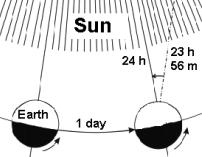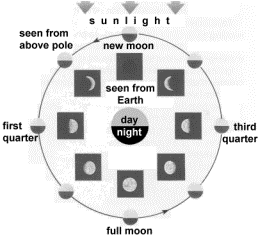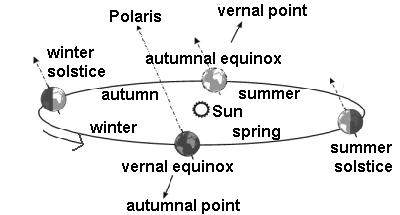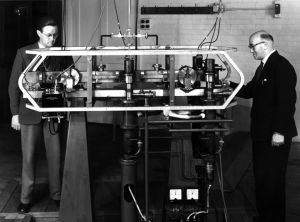


The Venus Transit 2004
... Brief InfoSheet G2
What is TIME?
Any regularly repeated phenomenon can be used to record the passage of time. Nature has given to our ancestors three phenomena as units of time:
| One Day (period of alternation of sunshine and night) is given by the rotation of the Earth around its axis. A solar day lasts about 4 minutes longer than one rotation with respect to the stars (about one degree more than 360 degrees). The centre of the solar disc (true sun) moves on the ecliptic with varying speed - faster in winter, slower in summer. Therefore a fictitious point - mean sun - was introduced by astronomers, which moves with constant speed on the celestial equator. The mean sun and the true sun meet once a year at the vernal point. |  |
| One revolution of the Moon around the Earth (= lunation) was used as a month and its quarter as a week. New moon, first quarter, full moon and last quarter are conspicuous for everybody everywhere and the time interval between them is seven days (one week) and 9 hours. The full lunation (=synodic month) lasts 29,5 days (1,5 day more than 4 weeks). The lunar calendar therefore alternates months with 29 days and 30 days. |  |
| One revolution of the Earth around the Sun is one year. The rythm of life in the biosphere (= the seasons) is given by the tropical year. It is the time interval between two transits of the Sun across the vernal point. The vernal point is shifting on the ecliptic towards the west, so that a tropical year is 20 minutes shorter than a full revolution of the Earth (=360 degrees) called a sidereal year). |  |
 Days, seasons of the year and phases of the Moon were sufficient forms of time measurement for simple nomadic and agricultural communities. During history devices were developed to improve timekeeping - counting the passage of time. The Chaldeans were the first people who introduced a 12 hour division of the day. They used sun clocks. Since then, improved forms of timekeepers followed: water clock, hour-glass, mechanical clock (with balance or pendulum), electrical clock (with a piezoelectric crystal) and atomic clock (with Cesium 133 or other atoms). Our way of life is fully dependent on accurate timing. Science, communication, transportation, manufacturing and other technologies are dependent on accurate clocks. The first atomic clock was constructed in England in the year 1955.
Days, seasons of the year and phases of the Moon were sufficient forms of time measurement for simple nomadic and agricultural communities. During history devices were developed to improve timekeeping - counting the passage of time. The Chaldeans were the first people who introduced a 12 hour division of the day. They used sun clocks. Since then, improved forms of timekeepers followed: water clock, hour-glass, mechanical clock (with balance or pendulum), electrical clock (with a piezoelectric crystal) and atomic clock (with Cesium 133 or other atoms). Our way of life is fully dependent on accurate timing. Science, communication, transportation, manufacturing and other technologies are dependent on accurate clocks. The first atomic clock was constructed in England in the year 1955.
Want to know more?
This topic is discussed in a more detailed way in the associated Extended InfoSheet.
Back to the List of Brief InfoSheets.


 Days, seasons of the year and phases of the Moon were sufficient forms of time measurement for simple nomadic and agricultural communities. During history devices were developed to improve timekeeping - counting the passage of time. The Chaldeans were the first people who introduced a 12 hour division of the day. They used sun clocks. Since then, improved forms of timekeepers followed: water clock, hour-glass, mechanical clock (with balance or pendulum), electrical clock (with a piezoelectric crystal) and atomic clock (with Cesium 133 or other atoms). Our way of life is fully dependent on accurate timing. Science, communication, transportation, manufacturing and other technologies are dependent on accurate clocks. The first atomic clock was constructed in England in the year 1955.
Days, seasons of the year and phases of the Moon were sufficient forms of time measurement for simple nomadic and agricultural communities. During history devices were developed to improve timekeeping - counting the passage of time. The Chaldeans were the first people who introduced a 12 hour division of the day. They used sun clocks. Since then, improved forms of timekeepers followed: water clock, hour-glass, mechanical clock (with balance or pendulum), electrical clock (with a piezoelectric crystal) and atomic clock (with Cesium 133 or other atoms). Our way of life is fully dependent on accurate timing. Science, communication, transportation, manufacturing and other technologies are dependent on accurate clocks. The first atomic clock was constructed in England in the year 1955. 


